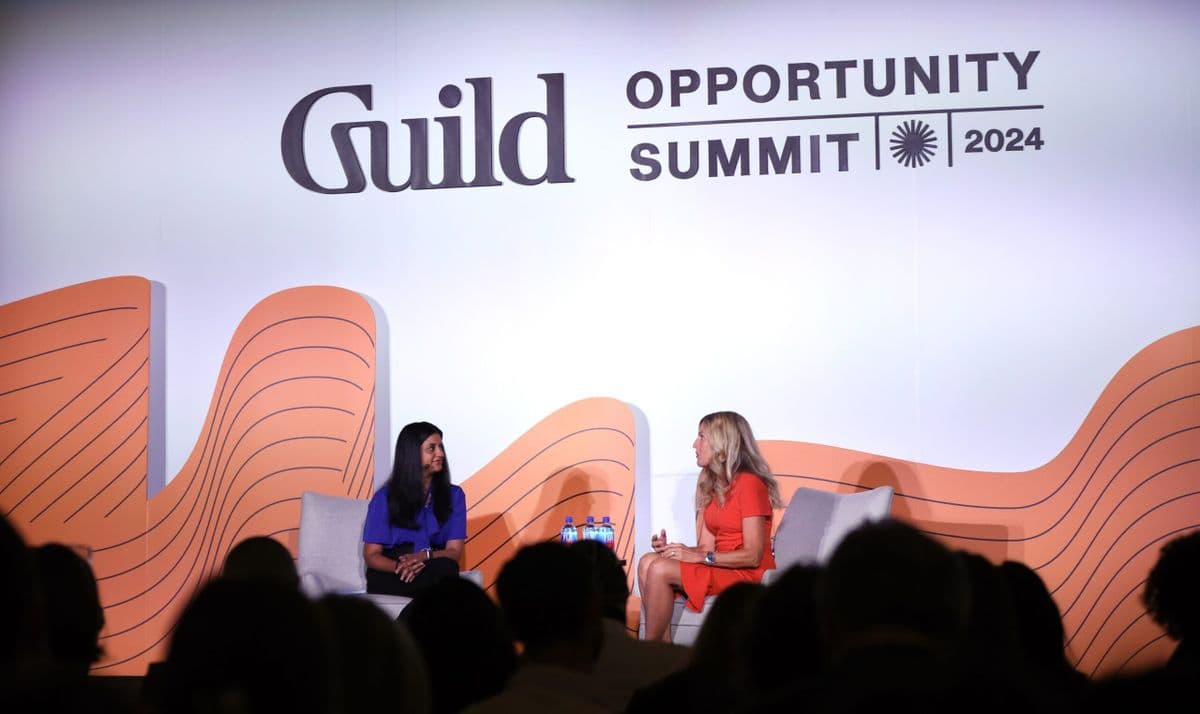Alex Cannon |
Last week at Guild’s Opportunity Summit in Nashville, hundreds of talent leaders gathered to discuss workforce challenges ranging from making the business case for skilling to trying to understand — and catch up in — AI.
“Every job in your company is going to change,” said Guild CEO Bijal Shah, who kicked off the event last week. “And we in HR and in [learning and development] have a huge opportunity to help with that and to support that – to reskill, to upskill, and to also redesign jobs and operating models of organizations to ensure that we can actually take advantage of all this great potential that AI creates.”
Shah added, “We think that AI is actually turning every employee – or has the potential to turn every employee – into a superpowered person. Basically superhuman.”
Below, we share the three biggest lessons we learned during the Summit, including practical steps and advice from expert practitioners for HR and talent leaders looking to drive meaningful impact in the face of so much change.
Big change starts small.
The sheer scope of undertaking large talent initiatives like workforce transformation skills-based organization (SBO) development can be paralyzing. Yet big change doesn’t require grand gestures — it can begin with one small, actionable step toward a well-defined, incremental goal.
David Mafe, chief diversity officer for UCHealth and the vice president of human resources for the system’s metro Denver region, suggested focusing on high-turnover, high-need areas as a tactical jumping off point. “High-volume roles are a great place to start, demonstrate some success, and get it rolling from there,” he said, adding that trying to spread change evenly across an organization can slow progress.
Although well-defined parameters can focus efforts and resources, transformation won’t be perfect out of the gate — and that is to be expected. Megan Lessard, vice president of people acquisition and inclusion for Sunrun, advised leaders to just start the conversation: “It doesn’t have to be neat. It can be messy,” adding that waiting until everything is perfectly aligned will only delay progress. Whether it’s skills, reskilling, or mobility, the culture of change starts with open conversations — even if the first steps are a bit chaotic. Leaders need to embrace the mess and start somewhere.
The approach recommended by Janel Taylor, senior vice president of learning strategy and talent management for Regions Bank, is to assemble a group of HR and talent leaders from across the business to come together to ensure upskilling decisions won’t be made in a vacuum. Forming a skills council or task force that includes representatives from HR, learning and development, talent acquisition, as well as business unit leaders to collaboratively steer skills-based efforts strengthens cross-functional support and helps ensure better business alignment.
Of course, it isn’t just the people you will drive change with but the people you drive change for whose opinions matter. Taking time to directly ask where work can be made easier can reveal surprising ways to improve the employee experience. “We have to dive deeper and ask people what's working for them and what they need,” explained Kathi Enderes, senior vice president of research and a global industry analyst at The Josh Bersin Company, pointing to an example of a healthcare organization that conducted focus groups with its nurses to ask what would make their work easier. The feedback the organization received led to a simple but impactful change: moving cabinets in hospital rooms to make daily tasks more efficient.
The journey to workforce transformation isn’t one to take alone.
Learning to speak the language of your most important stakeholders remains a common challenge. The most effective way to win support is to demonstrate how your initiative ladders up to the business metrics that keep them up at night. As attendees broke out into participatory sessions, these tips and tactics came up most frequently across industries:
Point directly to business challenges. Sometimes, selling a talent solution means selling the problem first. Do peer decision-makers understand that upskilling, reskilling, and workforce transformation are not vanity projects? The connection between these efforts and talent shortages, lagging productivity, and high turnover may not always be clear.
Know your bottom line. Facts matter more than feelings when speaking with operations leaders and CFOs. Failing to connect workforce initiatives to tangible, measurable (financial) outcomes can lead good ideas to go unsupported. Knowing the difference between hiring costs and upskilling costs is a good place to start.
Manage expectations. As much as everyone loves quick wins, the full impact of workforce transformation and education takes time. This doesn’t mean short-term impact isn’t there — it’s easy to find in 90-day retention rates, for example — but setting realistic expectations at the outset can position talent leaders to drive long-term results.
Exclude managers at your peril. Without manager buy-in, the best initiatives unravel. These are the people who are among those best positioned to socialize and promote new skilling and training opportunities, and to drive mobility for their team members. As Terrence Cummings, chief opportunity officer at Guild noted, transformation isn’t just a top-down affair — it has to be driven from within. Managers should therefore be activated as agents of change, not as afterthoughts.
Don’t leave AI to IT alone. Given its nature as a new technology, it can be easy to think of AI adoption as an IT-led revolution. “Leaders have to advocate at the team level in order for people to know that they can use AI,” Cummings said, stressing the role of managers in encouraging AI adoption.
Real transformation happens when managers champion initiatives at the ground level.
Make sure you’re asking the right questions.
There’s value in challenging prevailing assumptions about how to prepare for an uncertain future. The real risk isn’t in being wrong, but in being too comfortable with how things have been done to adapt to a changing world.
Joseph Fuller, professor of management practice at Harvard Business School, put this in stark terms when it comes to AI: "Generative AI is the single most important tool for enhancing the productivity of any organization since alternating current... This is electricity. This is not a new steam engine."
Although uncertainty, like growth, can be uncomfortable, leaders can cut through ambiguity by asking questions that probe underlying assumptions. Here are the questions you should be asking:
1. How can we help our employees adapt to AI?
Employees are largely curious about AI, and they’re waiting for the tools and permission to explore it. Fuller made this clear: “We have a big, big issue in terms of beginning down the path of causing people to learn about this. Workers... don’t know how to use this properly.”
Allowing employees to learn and use AI at work can lead to impressive productivity gains. Fuller shared several examples of improved productivity across different occupations, most notably the capacity AI has to help bridge experience gaps:

Believing that employees won’t adapt to AI can lead employers to think that they need to hire AI experts to fill emerging roles, when in reality, reskilling is the smarter, faster way to prepare for an AI-empowered future. Negative assumptions about workforce ability to build AI skills can hold organizations back from the critical work of building foundational literacy now.
2. Do we know which metrics matter the most — and can we measure them?
One breakout session at the Summit brought together HR and talent leaders from a range of industries to discuss common metrics and caveats when it comes to defining the success of a talent intervention.
Retention: The value of retention comes from context. Understanding the cost of turnover and the cost of acquisition (including cycle time) can help build the case that upskilling can be achieved at a lower financial cost than building internally. The caveat is that although retention is easy to quantify, it can be difficult to attribute.
Engagement scores: Engagement can be as fickle as the weather, and it can also act as a weather vane for employee interest and morale. But high engagement itself is not an outcome; it’s an output, and one that can indicate mood more than it measures progress.
Proficiency: A critical but elusive metric: What is it for a given task? When does it actually happen? For example, measuring time spent on a task alone does not necessarily indicate proficiency. Instead, it can be constructive to think of proficiency in terms of tasks, and whether those tasks can be automated or augmented by AI.
3. Do we see relevant job movement and skilling?
Whether talent development efforts result in an employee’s ability to achieve internal job mobility into priority roles — or to build the skills to continue to succeed in an evolving role — is the most important measure. Bridging role and skills gaps is the ultimate objective.
Leading change may need to begin with changing yourself.
Big change starts small, but don’t mistake small steps for small thinking. Real transformation happens when talent leaders ask the right questions, bring the right people along, and remember the foundation upon which bigger changes are scaled is built on small, consistent victories.



